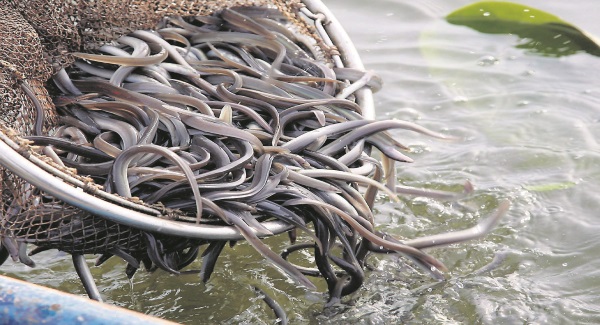Here's a problem to solve: up and down the rivers of Britain, and indeed across Europe, thousands of turbines are being installed to generate electricity. In our drive for 'green' energy they seem the ideal solution but aside from the large, big money projects a vast majority are small scale, bringing to life water mills that have lain idle for a century or more. So far, so good. But here's the issue. Turbines are not benign. Those blades rotate at a terrific speed, shredding in the blink of an eye, any living creature unfortunate enough to get sucked in. And sadly that is often eels and eels are one of the great ecological disaster stories of recent years. A population that used to sustain a whole industry on the chalkstreams is in headlong decline, by some estimates collapsing by as much as 90%.

Much is still unknown about the life of an eel, but in a nutshell the eel starts its life as an egg attached to the sargassum weed of the Sargasso Sea which lies off the east coast of Florida in the Atlantic. Once hatched the tiny elver hitches a ride on the Gulf Stream that carries it across the ocean for 3.500 miles to the shores of Europe. Seeking out freshwater by smell our international traveller is now 3-4 inches long, heading up a river system in search of a new home. Guided by who knows what the eel hauls himself from the water to find a damp ditch or pond where he will live out the next 10-20 years growing at no more than an inch a year.
Mature and ready to procreate he will use the same sense of smell to find his way back to the river, slivering through the meadow grass in the damp dew of morning. That was the easy bit. Once in the river it is back to the ocean and the return trip to the Sargasso Sea by catching a southern current, but this time the return trip that takes as much as a year. However, this is a one way ticket for the eel for once he re-enters saltwater he stops feeding and will gradually absorb his innards for nourishment, dying once spawning is completed back in the very place of his birth.
During the past decade the number of eels making this amazing round trip has declined dramatically. I've noticed it. Once I would have barely given an eel a second glance, today my sightings are fewer. You don't hear them sucking insects off the reeds at dusk and fish guts that were previously snatched away into the deep by the unseen jaws of ravenous eels now drift downstream unmolested. It is generally thought the collapse in stocks is due to a virus the European eel has caught from the Japanese eel out in the mid- Atlantic. The one or two commercial eel catchers that are left live off slender pickings.
|
|
| Eel traps: redundant for ever? |
So back to that problem - how do you prevent eels entering the turbines? A grille would seem the obvious solution but eels are so slender and lithe that the mesh would have to be so fine as to render the turbine inoperable. With up to third of every eel run being sliced up the scientists at Southampton University, England turned their minds to the problem but cunningly looked for a behavioural solution. The Irish Examiner takes up the story:
"The Southampton scientists wanted to find a way to warn eels of the danger. They began by studying the behaviour of the fish as they travelled down river. A hydro-electric station on the River Stour was taken out of service in the 1970s. It has derelict turbine bays where the team could adjust the flow and velocity of the water passing through them and simulate various conditions eels might encounter approaching a power-station. Forty migrating eels were captured and fitted with acoustic transponders. Eight hydrophones, fitted around the study site, enabled the locations and behaviour of the eels to be monitored. The eels were released upstream of the turbine, five at a time.
Three of the 40 swam upstream and did not enter the study bay. Most of the remaining 37 moved downstream "approaching the intake semi-passively". They followed the main flow but, on encountering a structure ahead of them, made multiple exploratory approaches before passing it. When the rate of water flow increased gradually, the eels continued to move with it, drifting into the turbine shaft. If the water flow began to increase suddenly, however, they avoided the turbine; sudden acceleration warns eels of impending danger.
If engineers can come up with devices to constrict the flow of water and increase it rapidly ahead of a turbine intake, it will be good news for eels. The sudden change in the speed of the water will alert eels to the impending danger. Engineering a slow steady flow towards a fish-pass, on the other hand, should persuade the frightened eels to use that route instead. This won't solve all of the eels' many problems but every little helps."
It is an amazing thought that a solution so simple might work.
.